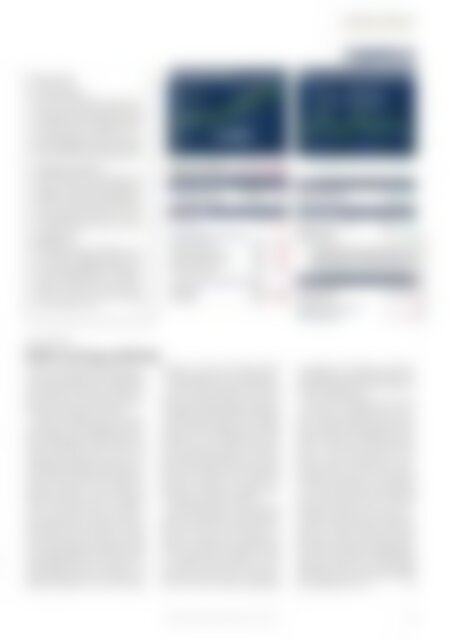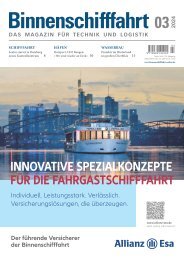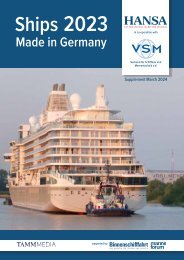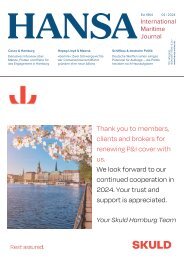HANSA 11-2019
LNG-Neubau Atair | Europort | MPP-Report | Finanzierung Asien und U.K. | Start-Ups | Makler & Agenturen | MARINTEC 2019 | Maritime Silk Road | 23. HANSA-Forum
LNG-Neubau Atair | Europort | MPP-Report | Finanzierung Asien und U.K. | Start-Ups | Makler & Agenturen | MARINTEC 2019 | Maritime Silk Road | 23. HANSA-Forum
Sie wollen auch ein ePaper? Erhöhen Sie die Reichweite Ihrer Titel.
YUMPU macht aus Druck-PDFs automatisch weboptimierte ePaper, die Google liebt.
MÄrkte-Markets<br />
Orders & Sales<br />
New Orders Container<br />
Only two orders were placed during the last<br />
four weeks. Eastern Pacific ordered <strong>11</strong> LNGfuelled<br />
ships at Korea`s Hyundai HI. Theygs<br />
are scheduled to be delivered between 2022 and<br />
2023 and are said to cost 136 mill. $ each. TVL<br />
Group purchased one 1,096 TEU vessel at<br />
Japanese shipbuilder Kyokuyo for delivery in<br />
2021. The shipbuilder already built three such<br />
vessels for TVL Group, all chartered to KMTC.<br />
Secondhand Sales Container<br />
Volumes were close to the level of the previous<br />
period. In total, nine vessels changed hands,<br />
ranging from 700 to 9,500 TEU. Tufton purchased<br />
the 2,546 TEU »Maria-Katharina S«<br />
for 8.6 mill. $, while BAL acquired 2007-built<br />
»O.M. Autumni« (704 TEU) for 2.7 mill. $.<br />
Danaos bought the 8,073 TEU vessel »Conti<br />
Champion« (2005) for 25 mill. $, currently<br />
on charter to MSC.<br />
Demolition Sales<br />
The situation remains unchanged – only a<br />
few vessels were sold for scrap. The market<br />
continues its sluggish development with<br />
most recycling candidates receiving prices<br />
below $400/ldt. However, Costamare<br />
achieved a strong price for one of its oldest<br />
ships. »MSC Sierra II« (2,024 TEU) was<br />
sold for scrap to Indian buyers for $418/ldt<br />
including 600 bunker tons. JG<br />
Container ship t / c market<br />
450<br />
400<br />
350<br />
23.04.19<br />
Container freight market<br />
WCI Shanghai-Rotterdam 1,210 $/FEU - 7.1 %<br />
WCI Shanghai-Los Angeles 1,402 $/FEU + 0.8 %<br />
Dry cargo / Bulk<br />
24.10.19<br />
Month on Month 442 • - 0,2 %<br />
Baltic Dry Index 1779 - 13.3 %<br />
Spot time charter averages ($/day)<br />
Capesize 5TC average 23,740 - 18.3 %<br />
Panamax 4TC average (74k) 15,101 - 7.1 %<br />
Supramax 10TC average (58k) 13,446 - 7.3 %<br />
Handysize 6TC average 9,294 - 7.4 %<br />
Forward / ffa front month Nov’19 ($/day)<br />
Capesize 180k 20,789 - 19.2 %<br />
Panamax 74k 13,389 - 2.8 %<br />
MPP<br />
October ’18<br />
$ 7,499<br />
TMI<br />
Toepfer’s Multipurpose Index<br />
October ’19<br />
$ 7,515<br />
12,500 tdw MPP/HL »F-Type« vessel for a 6-12 months TC<br />
Tankers<br />
Shortsea / Coaster<br />
Norbroker 3,500 dwt earnings est. 3,500 €/d + 25.0 %<br />
HC Shortsea Index 16.71 + 6.7 %<br />
ISTFIX Shortsea Index 531 + 9.7 %<br />
Norbroker: spot t/c equivalent assessment basis round<br />
voyage North Sea/Baltic; HC Shipping & Chartering index<br />
tracking spot freights on 5 intra-European routes; Istfix<br />
Istanbul Freight Index covering spot freight ex Black Sea<br />
Bunkers<br />
COMPASS<br />
Baltic Dirty Tanker Index 1312 + 54.5 %<br />
Baltic Clean Tanker Index 856 + 86.0 %<br />
IFO 380 Rotterdam $/t 242 - 34.6 %<br />
MGO Rotterdam $/t 582 + 0.0 %<br />
Forward / Swap price Q4 / 19<br />
IFO 380 Rotterdam $/t 245 - 5.8 %<br />
Data per 23.10.<strong>2019</strong>, Alterations within four weeks<br />
SPOTLIGHT<br />
Bulker earnings stabilising<br />
The dry cargo spot market has been in descent<br />
since the high of early September,<br />
with momentum down for capesize and<br />
panamax ships in the Atlantic and the Pacific.<br />
However, the downward trajectory<br />
flattened out during the last weeks.<br />
Average TC earnings seem to have found<br />
some support at levels around 24-25,000 $/<br />
day for capes and at 15,000 $/day for panamaxes<br />
(82,500 dwt) which is still strong<br />
compared with levels in recent years. Average<br />
rates for 58,000 dwt supramaxes and<br />
for 28,000 dwt handysize types were hovering<br />
at around 13,500 $ and 9,300 $/d at<br />
the time of writing – down around 7%<br />
month-on-month. As in the container<br />
market, the »scrubber effect« is considered<br />
to be a major factor for spot vessel earnings<br />
today, albeit exact data on the volume<br />
of tonnage tied up by retrofits is missing.<br />
The constraints seem to have gone a long<br />
way in neutralising the impact of soaring<br />
newbuilding deliveries in Q3 which were<br />
at their highest level since early 2017. Cargo<br />
demand also played a role, though, with<br />
combined imports of coal, iron ore and<br />
soyabeans in China reportedly reaching<br />
a record volume in Q3 – over 400 mill. t.<br />
In the panamax segment, grain liftings<br />
on the East Coast of South America continued<br />
to offer good support. Trade data<br />
for Argentina and Brazil showed that their<br />
combined exports surged to a record high<br />
in Q3, as broker Simpson Spence Young<br />
pointed out. Y-t-d volumes are up over<br />
15 mill. t at 66 mill. t which also benefited<br />
the smaller geared bulkers. Over in the<br />
Pacific, the coal trades have shown robust<br />
growth, with imports in China, India and<br />
some other southeast Asian countries set<br />
for steep y-o-y increases – a boon for panamaxes,<br />
supramaxes and handies.<br />
Market expectations for the rest of the<br />
year are split, though, as China might well<br />
apply strict import quotas again in the final<br />
weeks of the year. The question in<br />
that case is whether India can pick up the<br />
slack. Its coal imports are poised to reach<br />
a new high this year (perhaps as much<br />
as 214 mill. t against 187 mill. t last year).<br />
With steam coal inventories running at<br />
low levels of just ten days of nationwide<br />
consumption and domestic production<br />
restrained by an extended monsoon season<br />
and mining strikes, there could even<br />
be more upside potential.<br />
By contrast, the outlook for the steel and<br />
iron ore sector – the largest source of cargo<br />
for dry bulk shipping – has grown more<br />
uncertain lately. According to the short<br />
range outlook by the World Steel Association,<br />
y-o-y growth in steel demand will<br />
drop to 1.7% in 2020, down from 3.9%.<br />
The fall would be entirely due to slackening<br />
growth in China where demand is<br />
forecast to expand by just 1.0%, against<br />
+7.8% this year. On the other hand, the<br />
rest of the world will see steel demand<br />
growth pick up from 0.2% to 2.5%, according<br />
to World Steel. This will be driven<br />
by a recovery in Europe, South America<br />
and Africa. While a slowdown in China is<br />
bad news for capesize carriers that mainly<br />
serve China, more steel trading (and perhaps<br />
more importation of steel-making<br />
ingredients) in the rest of the world might<br />
spawn opportunities for smaller bulkers<br />
and multipurpose vessels.<br />
n<br />
<strong>HANSA</strong> International Maritime Journal <strong>11</strong> | <strong>2019</strong><br />
9


















